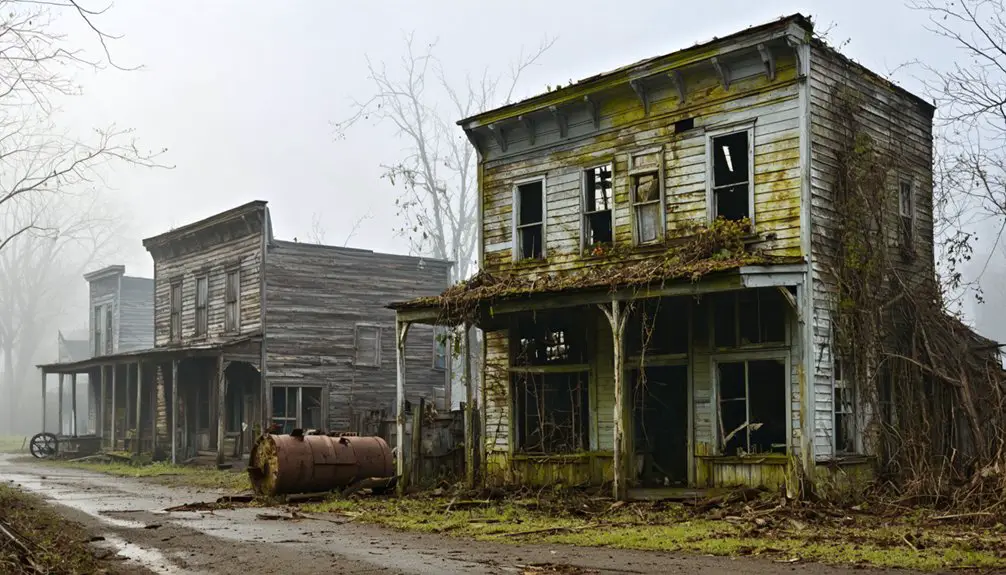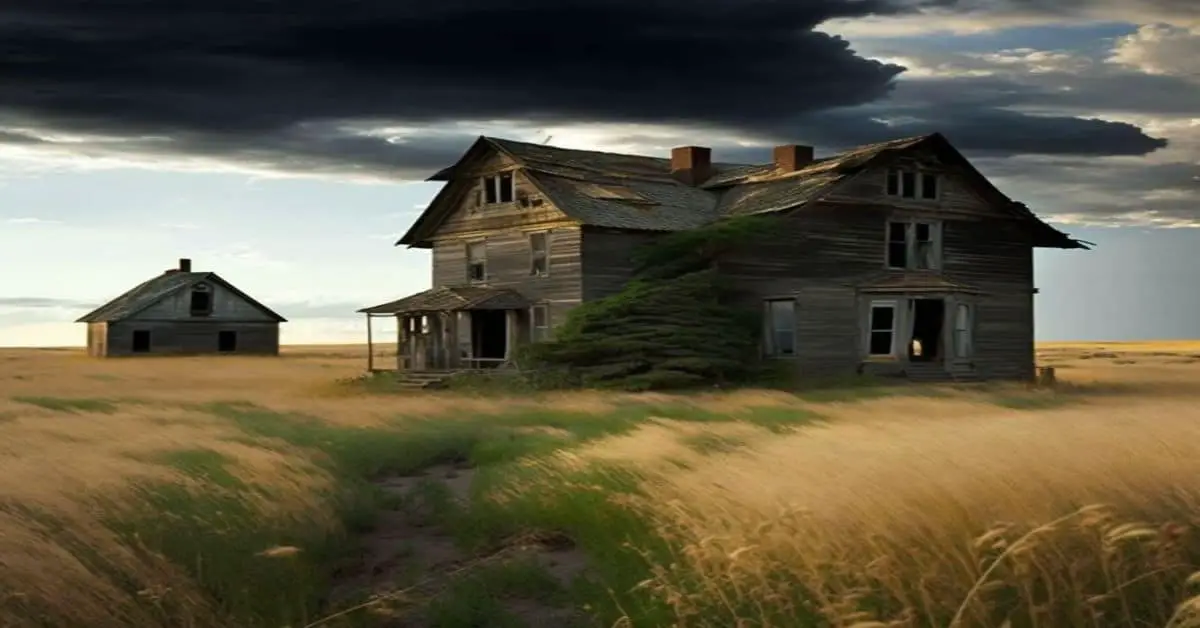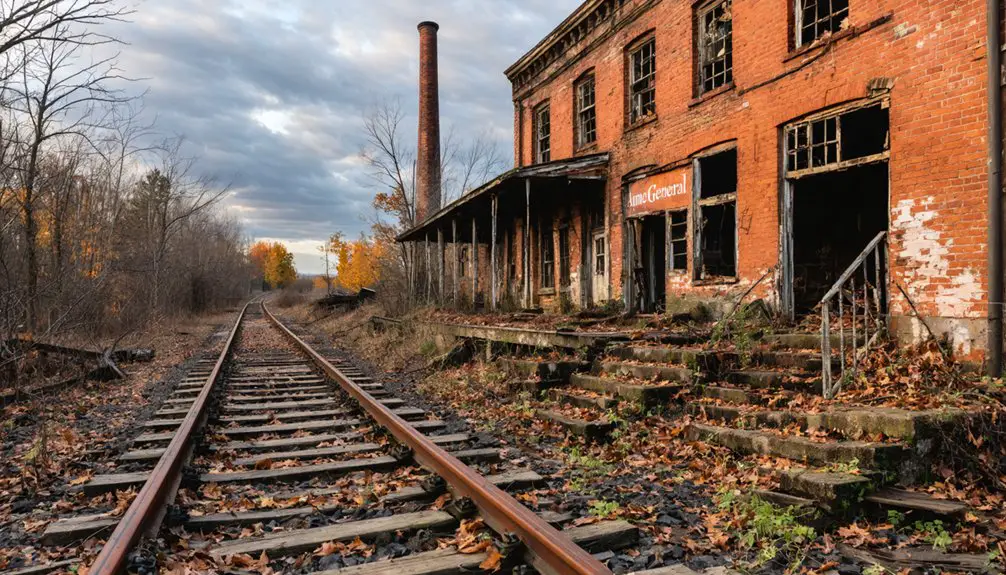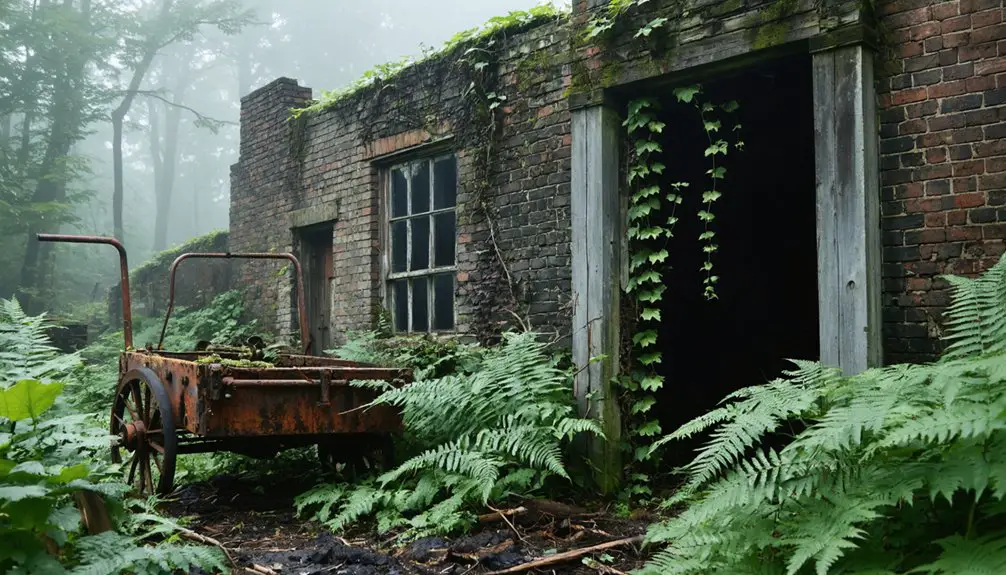You’ll find Garvers Ferry’s tragic transformation from bustling coal town to ghost town started in 1962 when an underground coal seam ignited. The fire forced most residents to evacuate as toxic gases seeped through ground cracks and steam vents appeared across town. Despite $42 million in government relocation funds, some residents refused to leave. Today, the underground inferno continues to burn, with experts predicting another 200-250 years of flames beneath this haunting Pennsylvania landscape.
Key Takeaways
- Garvers Ferry emerged as a thriving coal mining community during Pennsylvania’s 19th-century coal boom, fueled by rich bituminous coal deposits.
- The town’s economic backbone relied heavily on room-and-pillar mining operations and company-controlled stores for worker provisions.
- Local infrastructure included railroads and river routes, making Garvers Ferry a significant coal transportation hub in western Pennsylvania.
- A diverse population of miners, including Italian immigrants, created a close-knit community centered around taverns, churches, and social halls.
- Property values plummeted and residents relocated due to environmental hazards, transforming the once-bustling mining town into a ghost town.
The Birth of a Coal Mining Community
As Pennsylvania’s coal industry boomed in the 19th century, Garvers Ferry emerged as one of many mining communities dotting the western region’s landscape. The community origins can be traced to the discovery of rich bituminous coal seams that promised lucrative opportunities for both companies and workers seeking their fortune. Initially, coal extracted from the mines was transported by drift mines to reach nearby markets.
You’d have witnessed the rapid transformation of this once-quiet area as mining infrastructure sprouted up, including the essential transportation networks of railroads and river routes that would carry the precious black fuel to market.
The town’s development centered around room-and-pillar mining operations, where workers extracted coal using traditional methods. Like its neighboring coal towns, Garvers Ferry grew quickly to support the intensive extraction and processing activities that would define its existence for generations to come. In response to difficult working conditions and wage disputes, many local miners joined the labor movement that led to the formation of the United Mine Workers Union in 1890.
Life Before the Underground Inferno
You’d have found Garvers Ferry bustling with economic activity in its heyday, as coal mining operations provided steady work for multiple generations of local families who built their lives around the mines.
The community’s spirit came alive during weekend gatherings, where miners’ families would share meals, music, and stories at the company-owned social hall near the mining operations. The typical workday began early, with miners rising before dawn to prepare for their grueling shifts underground. The miners learned to effectively burn the coal for heat after iron grate systems were introduced in 1808.
Your neighbors back then were more than just fellow workers – they were part of an interconnected web of families who supported each other through the demanding lifestyle of a coal mining town.
Coal Mining Economic Hub
While Pittsburgh’s industrial growth fueled the demand for coal in western Pennsylvania, Garvers Ferry emerged as a thriving mining hub by the late 1800s.
You’d find miners performing backbreaking work in room-and-pillar mines, picking and hauling coal from dawn until late afternoon. The community’s economic dependency on coal shaped every aspect of daily life, from the company-owned store that controlled supplies to the modest homes where mining families settled. Like many mining communities, wages were paid through company store deductions.
Despite harsh working conditions and constant dangers like cave-ins and methane gas explosions, community resilience prevailed.
Immigrant workers, including many Italians, joined the workforce, creating a diverse population united by their reliance on mining income. The railroad’s expansion strengthened Garvers Ferry’s position as a crucial link in western Pennsylvania’s industrial chain.
Vibrant Community Gatherings
Before the underground mine fires consumed Garvers Ferry, the town pulsed with vibrant social life centered around its taverns, churches, and public spaces.
You’d find locals gathering at the inn to share news and celebrate community traditions, while seasonal festivals drew visitors from neighboring areas, strengthening social cohesion across the region.
The town’s parks and walking trails buzzed with activity as families enjoyed outdoor recreation, fishing tournaments, and casual strolls along Swatara Creek boundaries.
Churches organized social events beyond worship, bringing together congregations for charitable works and mutual support.
Along Hill Road and Horseshoe Pike, informal meetups flourished at natural gathering spots, where travelers, traders, and residents exchanged stories and ideas.
Schools hosted alumni events while historical societies preserved local heritage, keeping the town’s cultural identity alive through public commemorations and educational programs.
The five taverns along West Main Street became popular meeting places for both locals and travelers by 1800, serving as hubs for community discourse and fellowship.
Multi-Generational Family Roots
Since William Wurtz’s acquisition of coal lands in 1814, multi-generational families established deep roots throughout Garvers Ferry and neighboring mining towns.
You’d find Irish and Welsh immigrant families settling in the area, drawn by mining opportunities that would shape their family heritage for decades to come.
Your ancestors likely passed down the mining legacy through generations, with sons following fathers into the dangerous underground work.
You’d see extended families living close together, supporting each other through cave-ins, explosions, and chronic health issues.
Despite the physical toll and insufficient wages, these tight-knit communities preserved their cultural traditions and shared experiences through oral histories.
The economic dependency on coal meant your family’s livelihood remained inexorably tied to the mines’ success or failure.
By the 1870s, new waves of workers from central and southern Europe arrived, creating tension with established mining families.
The Fatal Decision of 1962
You wouldn’t think a routine trash fire could destroy an entire town, but that’s exactly what happened in May 1962 when Garvers Ferry officials decided to burn refuse in an abandoned strip mine pit.
The burning trash ignited an underground anthracite coal seam, setting off an uncontrollable subterranean blaze that would eventually force the evacuation of nearly all residents.
The town council’s ill-fated choice created an underground inferno that experts predict will continue burning for another 200 to 250 years, effectively sealing the town’s fate.
Initial mitigation efforts backfired when exploratory boreholes drilled actually provided more oxygen to fuel the underground flames.
The state government ultimately approved $42 million to relocate residents away from the dangerous underground fire.
Trash Fire Gone Wrong
In May 1962, a routine trash burning operation in an abandoned strip mining pit triggered one of America’s longest-burning mine fires.
What started as a seemingly innocent attempt at trash management quickly turned into an environmental catastrophe when the flames ignited an exposed coal seam beneath the surface.
Due to community negligence and initial underestimation of the situation, the fire spread rapidly through the underground network of coal veins.
You would’ve noticed the first signs of trouble as toxic gases began seeping from the ground and steam vents appeared across town.
Despite early attempts to control the blaze through firebreaks and flooding, the fire continued its relentless spread.
The burning coal seams created an unstoppable force that would eventually consume over 400 acres beneath Centralia and neighboring Byrnesville.
Town Council’s Fatal Choice
The roots of Centralia’s destruction trace back to a single town council meeting in 1962.
The town council’s disastrous decision to burn trash in an old strip mining pit near Odd Fellows Cemetery would seal the town’s fate. They’d chosen to ignite a controlled burn that accidentally set an exposed coal seam ablaze.
When solutions emerged, the council made critical errors.
They rejected a mine engineer’s $175 proposal to extinguish the fire and turned down a miner’s offer to do it for free. Instead, they opted for a $20,000 state-contracted company with limited working hours and restricted access.
The constrained operation failed, allowing the fire to spread beneath the town. These fatal choices led to Centralia’s eventual abandonment, transforming it into today’s ghost town.
A Town’s Battle Against the Flames
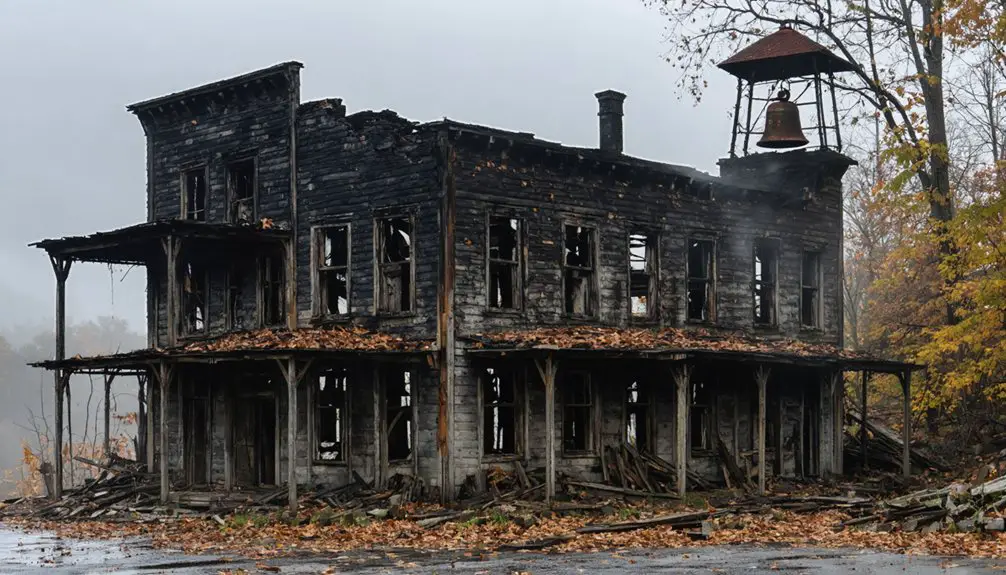
While modern firefighting technology helps protect communities today, Garvers Ferry and its neighboring towns faced significant fire risks throughout their history, leading to the establishment of multiple fire companies starting in 1831 with the Enterprise Fire Company.
Early fire risks in Garvers Ferry sparked a legacy of community protection, beginning with Enterprise Fire Company in 1831.
You’ll find that community resilience shaped the evolution of local fire prevention, as companies like Harmony, Friendship, and Cataract emerged to meet growing safety needs.
By the early 1900s, ward-based fire companies protected different areas, and fire police badges enhanced coordination efforts.
The Allegheny Township Volunteer Fire Company #1, incorporated in 1941, exemplifies this dedication to safety, even rebuilding after losing its own station to fire in 1981.
Today, you’ll see volunteer firefighters continuing this tradition, responding to everything from structure fires to downed power lines.
The Mass Exodus and Buyout Programs
As you’ll discover, the federal government’s relocation efforts in Garvers Ferry intensified during the early 1980s, following failed attempts to control the underground fire.
You’ll notice how property values dropped sharply as the toxic gases and sinkholes made homes increasingly unsafe and uninhabitable.
Many residents ultimately accepted final settlement offers, though some steadfastly refused to leave despite the deteriorating conditions and pressure from officials.
Federal Relocation Efforts Intensify
Following mounting concerns over the underground coal fire‘s devastating impact, federal and state governments launched extensive buyout programs in the early 1980s to relocate Garvers Ferry residents from their increasingly dangerous homes.
As toxic exposure risks escalated, federal intervention intensified through coordinated administrative efforts and grant programs specifically designed for coal mine fire disasters.
You’ll find that by 1992, Pennsylvania Governor Bob Casey invoked eminent domain, compelling resistant residents to accept buyouts and leave their properties.
The government spent over $40 million on relocation assistance, helping displaced families secure new homes in safer communities.
Despite legal challenges from some residents, the systematic evacuation continued as engineering reports confirmed the fire could burn for centuries, making the area permanently uninhabitable.
Property Values Plummet Rapidly
The mass exodus of Garvers Ferry residents triggered an unprecedented collapse in local property values during the 1980s and early 1990s.
You’d find homes selling for less than 60% of their previous worth as abandoned properties flooded the property market. The situation worsened when government buyout programs began acquiring homes at rock-bottom prices, further accelerating the economic decline.
What you’re seeing now reflects decades of deterioration – property values have fallen over 40% in just ten years.
If you’re looking at Garvers Ferry real estate, you’ll notice prices remarkably below neighboring communities. Banks have become hesitant to finance purchases, and the lack of commercial development, coupled with negative media coverage, has created a self-perpetuating cycle of devaluation that shows no signs of reversing.
Residents Choose Final Settlements
Residents of Garvers Ferry faced a defining choice in the early 1980s when Pennsylvania’s state government launched extensive buyout programs to address the growing safety concerns.
Resident sentiments were mixed as they weighed accepting collective buyouts worth $25 million against potential coal mining profits exceeding $400 million beneath their properties.
- Most residents ultimately chose safety over sentiment, accepting buyout offers and relocation assistance.
- A few holdouts remained, leading to legal battles that stretched into the 1990s.
- By 1992, official condemnation orders forced nearly complete community fragmentation.
- Final settlements in 2013 allowed remaining residents lifetime tenancy, but properties would revert to state ownership upon death.
The exodus effectively ended normal community life, with those who stayed facing isolation in an increasingly desolate landscape.
Environmental Impact and Landscape Changes
Since igniting in 1962, Centralia’s underground coal fire has dramatically transformed the landscape into an unstable, hazardous wasteland.
A devastating underground inferno has turned Centralia into a ghostly wasteland, where danger lurks beneath every step.
You’ll find temperatures exceeding 900°F beneath the surface, while toxic gases and steam vent through cracks in the ground. The environmental degradation has created a barren expanse where a thriving community once stood.
The landscape transformation is striking – sinkholes dot the terrain, foundations have tilted, and Route 61 had to be permanently closed.
You’ll see abandoned sidewalks leading nowhere, while steam vents installed in the 1980s punctuate the scarred earth. The fire’s spread across 400 acres has devastated local wildlife habitats and vegetation.
Nature has begun to reclaim the former town’s infrastructure, though areas near steam vents remain inhospitable due to extreme heat and gas emissions.
The Few Who Stayed Behind
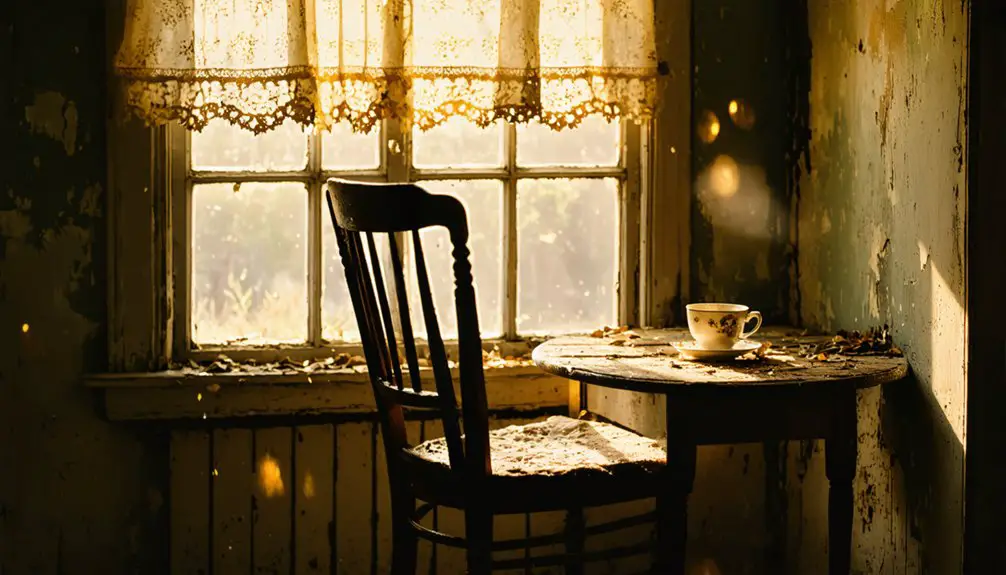
Among Centralia’s devastating environmental destruction, a handful of determined residents refused to abandon their homes. These holdouts, whose families trace back to the town’s 19th-century mining origins, fought legal battles to maintain their property rights.
Their community resilience and cultural identity drove them to stay, despite hazardous conditions and isolation.
- You’ll find these residents living amidst constant dangers – smoke plumes, carbon monoxide, and unexpected sinkholes.
- They’ve won the right to remain in their homes through 2013 legal challenges.
- Their properties stand as islands among condemned structures and deteriorating infrastructure.
- They’ve become symbols of persistence, though they face profound social isolation with few neighbors left.
Living in Garvers Ferry today means adapting to limited services while preserving deep generational ties to the land.
Graffiti Highway and Modern Tourism
Once an essential transportation artery, Pennsylvania Route 61 transformed into “Graffiti Highway” as Centralia’s underground mine fire forced its abandonment.
The deserted stretch became a magnet for urban exploration, with every inch covered in layers of street art ranging from simple tags to intricate murals. This spontaneous gallery represented a powerful form of folk art expression, chronicling the area’s industrial decline through countless visitor contributions.
You’d find pedestrians, off-road vehicles, and history enthusiasts drawn to the eerie atmosphere, often witnessing smoke seeping through highway cracks.
The graffiti significance extended beyond mere vandalism, inspiring local culture and becoming a symbol of resilience.
However, in 2020, the landowner buried the highway under dirt to prevent liability issues, marking the end of this unique cultural landmark – though its legacy lives on through photographs and personal accounts.
Tales From Former Residents
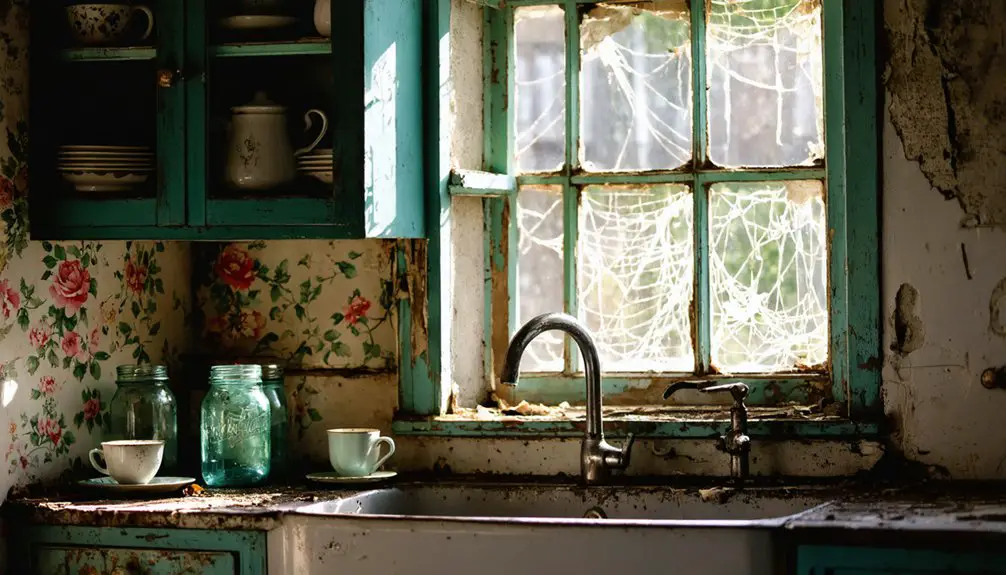
Before the mine fire transformed Centralia into a ghost town, approximately 1,500 residents called this close-knit mining community home. Life revolved around the coal mines, with personal memories centered on vibrant streets filled with shops, schools, and churches.
As the underground fire spread after 1962, residents faced toxic gases, sinkholes, and mounting pressure to abandon their homes.
- Many families resisted federal buyouts, choosing to stay despite hazardous conditions
- Former residents recall sudden sinkholes opening and smoke rising from the ground
- Disputes erupted over control of community identity items like the time capsule
- Those who stayed demonstrated unwavering attachment to their ancestral land
The town’s story reflects a deep-rooted community identity, where some chose freedom amid danger over forced relocation, maintaining their connection to generations of mining heritage.
Lessons From a Pennsylvania Disaster
The devastating collapse of South Fork Dam in 1889 released 20 million tons of water onto Johnstown, Pennsylvania, creating one of America’s worst civilian disasters.
You’ll find the catastrophe’s key lessons still resonate in today’s dam safety practices. The tragedy exposed how essential infrastructure neglect, like removing vital piping and poor maintenance, can lead to catastrophic failure.
The disaster management response changed American emergency services forever. Clara Barton led the American Red Cross in a five-month relief effort, establishing the organization’s reputation for disaster response.
While no one was legally held accountable, the flood’s aftermath sparked significant changes in civil engineering standards and dam safety oversight.
Today, the National Dam Safety Program exists because we learned from Johnstown’s devastating loss of 2,209 lives.
Frequently Asked Questions
Can Visitors Legally Explore Centralia’s Remaining Buildings and Structures Today?
You can’t legally explore Centralia’s remaining buildings due to strict exploring regulations and safety concerns. Most structures are off-limits, with “No Trespassing” signs and active enforcement of restrictions.
What Happened to the Bodies in Centralia’s Cemeteries After Abandonment?
Unlike tales of disturbed graves, you’ll find Centralia’s dead rest undisturbed. The bodies remain in their original plots, as cemetery preservation efforts left both Odd Fellows and Peter and Paul cemeteries intact despite the town’s abandonment.
How Do the Few Remaining Residents Get Basic Utilities and Services?
You’ll rely on self-sufficient systems for utility access: solar panels or generators for power, private wells for water, septic tanks for waste, and propane for heat to guarantee resident survival.
Are There Any Active Plans to Finally Extinguish the Underground Fire?
Like an eternal flame beneath your feet, the underground fire burns on without hope. You won’t find any active extinguishing plans – authorities focus on containing hazards rather than stopping it completely.
What Wildlife Species Have Adapted to Living in Centralia’s Toxic Environment?
You’ll find that large wildlife hasn’t adapted to Centralia’s toxic environment. Only microbes, particularly heat-loving bacteria, have truly evolved to thrive in the extreme conditions of the underground fire zone.
References
- https://www.youtube.com/watch?v=8QDb8y9Nszs
- https://pabucketlist.com/the-rise-and-fall-of-centralia-pas-toxic-ghost-town/
- https://www.youtube.com/watch?v=Qj5LjacccJ0
- https://www.youtube.com/watch?v=HHPt6Tbbx7E
- https://www.jeffreydonenfeld.com/blog/2009/12/exploring-the-ghost-town-of-centralia-pennslvania/
- https://www.iup.edu/library/departments/archives/coal/coal-culture-timeline.html
- https://www.pa.gov/agencies/dep/programs-and-services/mining/bureau-of-mining-programs/pa-mining-history.html
- https://raystown.org/blog/post/coal-mining-a-hard-knock-life/
- https://en.wikipedia.org/wiki/History_of_anthracite_coal_mining_in_Pennsylvania
- https://www.youtube.com/watch?v=z72KgmzhMtU
